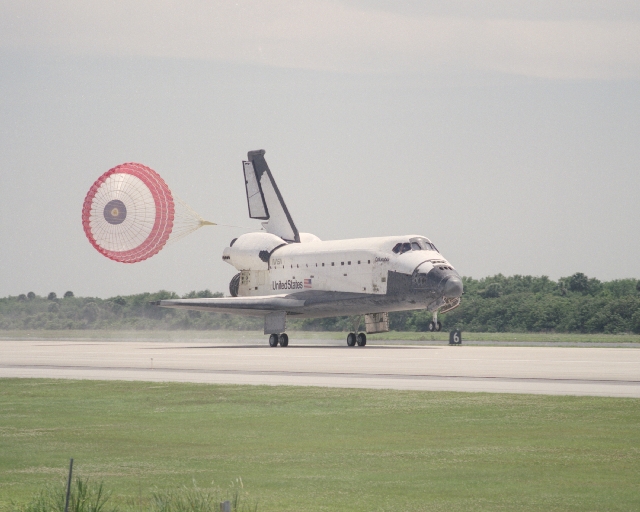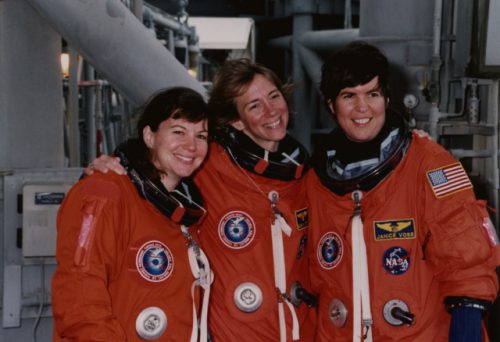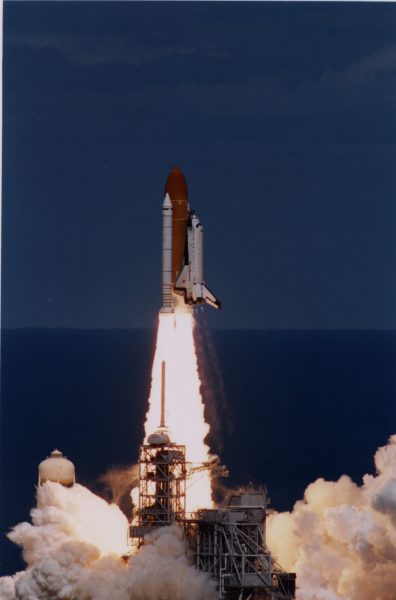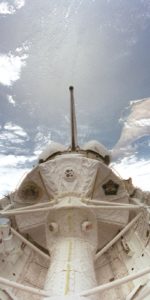
Eighty-four days. A mere 12 weeks on Earth, 84 days was the time spent aloft by the record-setting final crew of America’s Skylab space station. It was also the time elapsed between the landing and launch of a remarkable Space Shuttle crew in April and July 1997, which saw seven U.S. astronauts secure the empirical record for the shortest interval between returning from one space mission and rocketing to orbit on another. In so doing, all seven astronauts—Commander Jim Halsell, Pilot Susan Still, Mission Specialists Janice Voss, Mike Gernhardt and Don Thomas and Payload Specialists Roger Crouch and Greg Linteris—surpassed the previous record-holder, Steve Nagel, who had secured 128 days between flights in the summer and fall of 1985. In the words of Halsell, flying twice in such a short span of time represented was nothing less than “a marvelous, once-in-a-career opportunity”.
Launched 20 years ago, this week, STS-83 was dedicated as the Microgravity Science Laboratory (MSL-1) mission, devoted to materials processing, combustion science and fluid physics, on the second-to-last voyage of the European-built Spacelab pressurized module. With the construction of the International Space Station (ISS) then targeted to commence in 1998, much future research was slated to occur aboard the sprawling orbital complex. Only one other “standalone” mission—Columbia’s ill-fated STS-107 in early 2003—would provide a dedicated laboratory for microgravity sciences. Many within NASA and the physical sciences community therefore knew that MSL-1 was likely their last throw of the dice before the ISS came online.

The crew for the mission was highly experienced. In January 1996, more than a year before launch, veteran astronauts Janice Voss and Don Thomas—the former an aeronautical and astronautical engineer, the latter a materials scientist—were named as Mission Specialists, followed shortly thereafter by the announcement of physicist Roger Crouch and mechanical engineer Greg Linteris as Payload Specialists. Working across two 12-hour shifts, these four astronauts would support more than 25 experiments inside the 23-foot-long (7-meter) Spacelab module. By the end of May 1996, Commander Jim Halsell, Pilot Susan Still and Mission Specialist Mike Gernhardt had been named to round out the STS-83 crew, with a scheduled launch date in March 1997.
By the early spring of the following year, the astronauts worked crisply towards their flight…when, all at once, a potential show-stopper occurred. On 29 January, after completing an emergency egress training session at the Johnson Space Center (JSC) in Houston, Texas, Don Thomas slipped down some stairs and broke his ankle. With only nine weeks remaining before launch, the very real possibility that Thomas might not recover in time obliged NASA to assign veteran astronaut Catherine “Cady” Coleman to train alongside him. She would step up to join the STS-83 crew in Thomas’ place, if needed. “We are hopeful that Don will be cleared for flight,” said NASA’s then-head of Flight Crew Operations, Dave Leestma. “He is an experienced astronaut with the majority of his required training for this flight already complete. The decision to assign Cady as backup was made to protect all available options.”
Thomas, meanwhile, was determined to be ready in time for STS-83’s scheduled launch date, which had by this point moved to no sooner than 3 April. “I’m in a period of pretty heavy physical therapy right now,” he told journalists on 13 March, “spending about five or six hours a day walking in swimming pools, walking with the cast and without the cast, just getting my mobility strength back. We’ve got three weeks until launch and there’s no doubt in my mind or the doctor’s mind that I’ll be ready in time.”
By the beginning of April, the Mission Management Team (MMT) opted to postpone the launch by 24 hours until the 4th, due to an improperly insulated water coolant line in shuttle Columbia’s payload bay. There existed a possibility that it might freeze during the flight and technicians worked to install new thermal blankets. With liftoff now rescheduled for 2:00 p.m. EDT, the only constraint seemed to be a slight chance of rain showers generated by sea breezes. Mission managers briefly considered, but later discarded, an option to launch STS-83 an hour earlier than planned at 1:07 p.m. to provide more daylight at the Transoceanic Abort Landing (TAL) site at Banjul in West Africa and alleviate concerns about delamination of a backup antenna there.

“Not nervous at all,” was the recollection of Susan Still, who was making her first spaceflight and became only the second woman—after Eileen Collins—to serve as a shuttle pilot. “I’m mentally reviewing procedures and waiting with excitement for when I get to start moving switches in preparation for launch.” Following a slight delay in evacuating the closeout crew from the launch pad’s danger area and a problem with excessive concentrations of oxygen in the payload bay, Columbia thundered into orbit at 2:20 p.m. “A research bridge to the space benefits of tomorrow,” was the send-off comment from the NASA launch commentator, as NASA’s oldest shuttle—then embarking on her 22nd voyage—speared towards an orbit of 186 miles (300 km), inclined 28.5 degrees to the equator.
There was, in Still’s words, “no stopping us now”, and she remembered some surprise, as the vibrations were lower than she had anticipated from training. “The acceleration off the launch pad was less than I’ve experienced catapulting off of aircraft carriers,” she said, creating an analog with her previous career as a Navy test pilot. “But soon, things got pretty exciting. When I started feeling the G-forces, pressing down on my chest, I knew I was accelerating faster than ever before. Zero to over 17,500 miles per hour…in only eight-and-a-half minutes. Now that’s pretty exciting!” Equally exciting was the separation of the twin Solid Rocket Boosters (SRBs) at two minutes into the flight, which produced a blinding flash of light across Columbia’s forward windows and generated a spontaneous exultation of “Wow!” from the flight deck crew.
STS-83 was the tenth flight of the Extended Duration Orbiter (EDO) hardware, whose additional reserves of cryogenic oxygen and hydrogen reactants enabled a long flight of up to 16 days. Within hours, the crew had divided themselves into their two 12-hour shifts, with Halsell, Still, Thomas and Linteris of the “red team” heading directly to bed for their first sleep period, whilst “blue team” members Gernhardt, Voss and Crouch set to work opening the hatch into the Spacelab and setting up its systems for more than two weeks of intensive scientific research. Their primary focus was upon crystal growth, combustion science and the development of techniques to fabricate stronger metals and alloys.
“Everything’s going great!” remarked MSL-1 Mission Manager Teresa Vanhooser of NASA’s Marshall Space Flight Center (MSFC) in Huntsville, Ala., as the experiments got underway on the evening of 4 April. Her words proved disappointingly prophetic, for the fortunes of STS-83 and her crew were about to drastically change to the worse.
The second part of this article will appear tomorrow.
Be sure to “LIKE” AmericaSpace on Facebook and follow us on Instagram & Twitter!





